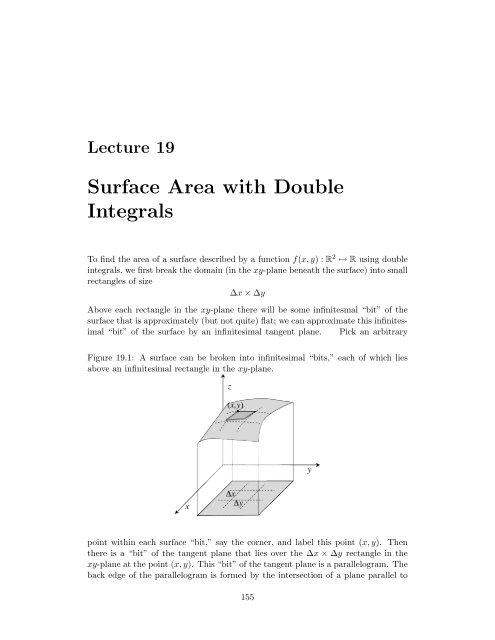Multivariate Calculus - Bruce E. Shapiro
Multivariate Calculus - Bruce E. Shapiro Multivariate Calculus - Bruce E. Shapiro
154 LECTURE 18. DOUBLE INTEGRALS IN POLAR COORDINATES Revised December 6, 2006. Math 250, Fall 2006
Lecture 19 Surface Area with Double Integrals To find the area of a surface described by a function f(x, y) : R 2 ↦→ R using double integrals, we first break the domain (in the xy-plane beneath the surface) into small rectangles of size ∆x × ∆y Above each rectangle in the xy-plane there will be some infinitesmal “bit” of the surface that is approximately (but not quite) flat; we can approximate this infinitesimal “bit” of the surface by an infinitesimal tangent plane. Pick an arbitrary Figure 19.1: A surface can be broken into infinitesimal “bits,” each of which lies above an infinitesimal rectangle in the xy-plane. point within each surface “bit,” say the corner, and label this point (x, y). Then there is a “bit” of the tangent plane that lies over the ∆x × ∆y rectangle in the xy-plane at the point (x, y). This “bit” of the tangent plane is a parallelogram. The back edge of the parallelogram is formed by the intersection of a plane parallel to 155
- Page 115 and 116: LECTURE 14. UNCONSTRAINED OPTIMIZAT
- Page 117 and 118: LECTURE 14. UNCONSTRAINED OPTIMIZAT
- Page 119 and 120: LECTURE 14. UNCONSTRAINED OPTIMIZAT
- Page 121 and 122: LECTURE 14. UNCONSTRAINED OPTIMIZAT
- Page 123 and 124: LECTURE 14. UNCONSTRAINED OPTIMIZAT
- Page 125 and 126: LECTURE 14. UNCONSTRAINED OPTIMIZAT
- Page 127 and 128: LECTURE 14. UNCONSTRAINED OPTIMIZAT
- Page 129 and 130: Lecture 15 Constrained Optimization
- Page 131 and 132: LECTURE 15. CONSTRAINED OPTIMIZATIO
- Page 133 and 134: LECTURE 15. CONSTRAINED OPTIMIZATIO
- Page 135 and 136: LECTURE 15. CONSTRAINED OPTIMIZATIO
- Page 137 and 138: LECTURE 15. CONSTRAINED OPTIMIZATIO
- Page 139 and 140: Lecture 16 Double Integrals over Re
- Page 141 and 142: LECTURE 16. DOUBLE INTEGRALS OVER R
- Page 143 and 144: LECTURE 16. DOUBLE INTEGRALS OVER R
- Page 145 and 146: LECTURE 16. DOUBLE INTEGRALS OVER R
- Page 147 and 148: Lecture 17 Double Integrals over Ge
- Page 149 and 150: LECTURE 17. DOUBLE INTEGRALS OVER G
- Page 151 and 152: LECTURE 17. DOUBLE INTEGRALS OVER G
- Page 153 and 154: LECTURE 17. DOUBLE INTEGRALS OVER G
- Page 155 and 156: LECTURE 17. DOUBLE INTEGRALS OVER G
- Page 157 and 158: Lecture 18 Double Integrals in Pola
- Page 159 and 160: LECTURE 18. DOUBLE INTEGRALS IN POL
- Page 161 and 162: LECTURE 18. DOUBLE INTEGRALS IN POL
- Page 163 and 164: LECTURE 18. DOUBLE INTEGRALS IN POL
- Page 165: LECTURE 18. DOUBLE INTEGRALS IN POL
- Page 169 and 170: LECTURE 19. SURFACE AREA WITH DOUBL
- Page 171 and 172: LECTURE 19. SURFACE AREA WITH DOUBL
- Page 173 and 174: Lecture 20 Triple Integrals Triple
- Page 175 and 176: LECTURE 20. TRIPLE INTEGRALS 163 Fi
- Page 177 and 178: LECTURE 20. TRIPLE INTEGRALS 165 so
- Page 179 and 180: LECTURE 20. TRIPLE INTEGRALS 167 Tr
- Page 181 and 182: Lecture 21 Vector Fields Definition
- Page 183 and 184: LECTURE 21. VECTOR FIELDS 171 Defin
- Page 185 and 186: LECTURE 21. VECTOR FIELDS 173 Examp
- Page 187 and 188: Lecture 22 Line Integrals Suppose t
- Page 189 and 190: LECTURE 22. LINE INTEGRALS 177 Exam
- Page 191 and 192: LECTURE 22. LINE INTEGRALS 179 ener
- Page 193 and 194: LECTURE 22. LINE INTEGRALS 181 The
- Page 195 and 196: LECTURE 22. LINE INTEGRALS 183 so t
- Page 197 and 198: LECTURE 22. LINE INTEGRALS 185 wher
- Page 199 and 200: LECTURE 22. LINE INTEGRALS 187 The
- Page 201 and 202: LECTURE 22. LINE INTEGRALS 189 The
- Page 203 and 204: Lecture 23 Green’s Theorem Theore
- Page 205 and 206: LECTURE 23. GREEN’S THEOREM 193 T
- Page 207 and 208: Lecture 24 Flux Integrals & Gauss
- Page 209 and 210: LECTURE 24. FLUX INTEGRALS & GAUSS
- Page 211 and 212: LECTURE 24. FLUX INTEGRALS & GAUSS
- Page 213 and 214: Lecture 25 Stokes’ Theorem We hav
- Page 215 and 216: LECTURE 25. STOKES’ THEOREM 203 S
Lecture 19<br />
Surface Area with Double<br />
Integrals<br />
To find the area of a surface described by a function f(x, y) : R 2 ↦→ R using double<br />
integrals, we first break the domain (in the xy-plane beneath the surface) into small<br />
rectangles of size<br />
∆x × ∆y<br />
Above each rectangle in the xy-plane there will be some infinitesmal “bit” of the<br />
surface that is approximately (but not quite) flat; we can approximate this infinitesimal<br />
“bit” of the surface by an infinitesimal tangent plane. Pick an arbitrary<br />
Figure 19.1: A surface can be broken into infinitesimal “bits,” each of which lies<br />
above an infinitesimal rectangle in the xy-plane.<br />
point within each surface “bit,” say the corner, and label this point (x, y). Then<br />
there is a “bit” of the tangent plane that lies over the ∆x × ∆y rectangle in the<br />
xy-plane at the point (x, y). This “bit” of the tangent plane is a parallelogram. The<br />
back edge of the parallelogram is formed by the intersection of a plane parallel to<br />
155



